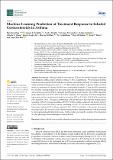| dc.contributor.author | Ong, Mei-Sing | |
| dc.contributor.author | Sordillo, Joanne E. | |
| dc.contributor.author | Dahlin, Amber | |
| dc.contributor.author | McGeachie, Michael | |
| dc.contributor.author | Tantisira, Kelan | |
| dc.contributor.author | Wang, Alberta L. | |
| dc.contributor.author | Lasky-Su, Jessica | |
| dc.contributor.author | Brilliant, Murray | |
| dc.contributor.author | Kitchner, Terrie | |
| dc.contributor.author | Roden, Dan M. | |
| dc.contributor.author | Weiss, Scott T. | |
| dc.contributor.author | Wu, Ann Chen | |
| dc.date.accessioned | 2024-03-27T15:34:13Z | |
| dc.date.available | 2024-03-27T15:34:13Z | |
| dc.date.issued | 2024-02-25 | |
| dc.identifier.issn | 2075-4426 | |
| dc.identifier.uri | https://hdl.handle.net/1721.1/153948 | |
| dc.description.abstract | Background: Although inhaled corticosteroids (ICS) are the first-line therapy for patients with persistent asthma, many patients continue to have exacerbations. We developed machine learning models to predict the ICS response in patients with asthma. Methods: The subjects included asthma patients of European ancestry (<i>n</i> = 1371; 448 children; 916 adults). A genome-wide association study was performed to identify the SNPs associated with ICS response. Using the SNPs identified, two machine learning models were developed to predict ICS response: (1) least absolute shrinkage and selection operator (LASSO) regression and (2) random forest. Results: The LASSO regression model achieved an AUC of 0.71 (95% CI 0.67–0.76; sensitivity: 0.57; specificity: 0.75) in an independent test cohort, and the random forest model achieved an AUC of 0.74 (95% CI 0.70–0.78; sensitivity: 0.70; specificity: 0.68). The genes contributing to the prediction of ICS response included those associated with ICS responses in asthma (<i>TPSAB1, FBXL16</i>), asthma symptoms and severity (<i>ABCA7, CNN2, PTRN3,</i> and <i>BSG/CD147</i>), airway remodeling (<i>ELANE, FSTL3</i>), mucin production (<i>GAL3ST</i>), leukotriene synthesis (<i>GPX4</i>), allergic asthma (<i>ZFPM1, SBNO2</i>), and others. Conclusions: An accurate risk prediction of ICS response can be obtained using machine learning methods, with the potential to inform personalized treatment decisions. Further studies are needed to examine if the integration of richer phenotype data could improve risk prediction. | en_US |
| dc.publisher | MDPI AG | en_US |
| dc.relation.isversionof | 10.3390/jpm14030246 | en_US |
| dc.rights | Creative Commons Attribution | en_US |
| dc.rights.uri | https://creativecommons.org/licenses/by/4.0/ | en_US |
| dc.source | Multidisciplinary Digital Publishing Institute | en_US |
| dc.subject | Medicine (miscellaneous) | en_US |
| dc.title | Machine Learning Prediction of Treatment Response to Inhaled Corticosteroids in Asthma | en_US |
| dc.type | Article | en_US |
| dc.identifier.citation | Journal of Personalized Medicine 14 (3): 246 (2024) | en_US |
| dc.identifier.mitlicense | PUBLISHER_CC | |
| dc.eprint.version | Final published version | en_US |
| dc.type.uri | http://purl.org/eprint/type/JournalArticle | en_US |
| eprint.status | http://purl.org/eprint/status/PeerReviewed | en_US |
| dc.date.updated | 2024-03-27T13:15:37Z | |
| dspace.date.submission | 2024-03-27T13:15:37Z | |
| mit.journal.volume | 14 | en_US |
| mit.journal.issue | 3 | en_US |
| mit.license | PUBLISHER_CC | |
| mit.metadata.status | Authority Work and Publication Information Needed | en_US |
